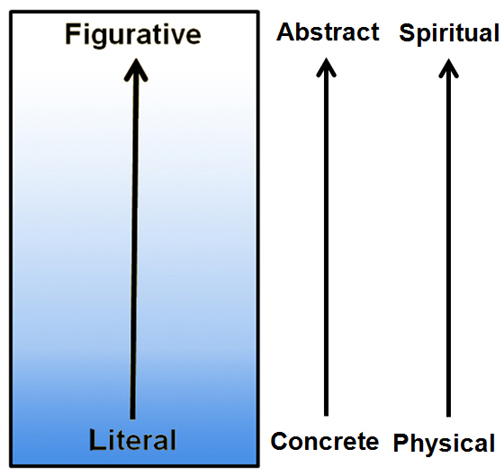Understanding Biblical revelation can be experienced.

I am a Christian, a follower and a disciple of Jesus Christ. I believe that the all-powerful, the all-knowing, and the every-where present God was and is incarnate in the man that history knows as Jesus of Nazareth. I believe that Jesus was not just a good man, a masterful teacher, and a charismatic prophet but was and is God manifested in the flesh. In the mystery of the nature of God and the nature of humanity coming together to form the God-man Jesus, the pathway for man to experience and to know God has been forever revealed (John 8:12). Understanding Biblical revelation is possible through the Jesus Christ.
Understanding Biblical revelation is trustworthy only through Jesus.
Since Jesus is the perfect embodiment of God in man, I believe his spoken words, his teachings, are inerrant and totally trustworthy (John 14:6).. The stories concerning not only the events of his earthly life but of his human heritage that has come down to us in what we know as the Bible are trustworthy. I believe these stories have changed the lives of an innumerable quantity of people since they were first told and eventually written in essence for all to read.
The difficulty of the spoken and the written narratives is not whether they are trustworthy but the obscurity of the real meaning of each story. For example, it is often said, “If the Bible says it, then you can believe it.” As important as what the Bible says is, however, it cannot compare to what the Bible means when it says it. The Bible does mean what it says and says what it means, but who determines what it actually means when the Bible says it.
Understanding Biblical revelation is determined only by Jesus.
Compounding the issue of what the Bible means when it says something is metaphors, similes, symbols, and many other figures of speech that are used to tell the story of God interacting in the world. A figure of speech is a word (or words) that is used not in its literal meaning (literal definition of the word) to enable the author to better tell the story. For example, Jesus said, “He that believeth on me, as the scripture hath said, out of his belly shall flow rivers of living water” (John 7:38). The word belly does not refer literally to the stomach of man but it is a figure of speech for man’s inner most being, his soul. Also, when God said to the Children of Israel, “Ye have seen what I did unto the Egyptians, and how I bare you on eagles’ wings, and brought you unto myself” (Ex. 19:4), he is not referring to the fact that he delivered them out of Egypt on the wings of a bird.
There are literally thousands upon thousands figures of speech used in the Bible. Not only is the number staggering, but there are many different types of figures of speech found in the Scriptures. The three most numerically used figures of speech are metaphor, simile, and symbols. It has been suggested (Wikipedia, the free internet encyclopedia) that there are over 5,400 metaphors, 3,450 similes, and 1,670 symbols used in the Bible.
Understanding Biblical revelation often comes by metaphors, similes, and symbols.
A metaphor is a tool of written and spoken communication that declares one thing to be or represents something else. For example, “the Lord is my shepherd . . .” is a metaphor. The great “I am” statements of Jesus are metaphors: “I am . . . the bread of life;” “. . . the light of the world;” . . . the door;” and “. . . the vine.” Perhaps, the most challenging metaphor of Jesus, in the light of many in the visible church, is “And when he had given thanks, he brake it, and said, Take, eat: this is my body, which is broken for you: this do in remembrance of me.” (1 Cor. 11:24). Is Jesus using a metaphor or making a literal statement?
A simile is a figure of speech that compares one thing to something else. A simile will always use the words “as” or “like.” Again someone has counted and found as is used 2,872 times and like is used 581 times. For example, “Woe unto you, scribes and Pharisees, hypocrites! for ye are like unto whited sepulchers, which indeed appear beautiful outward, but are within full of dead men’s bones, and of all uncleanness.” (Matt. 23:27). The men of the scribes and Pharisees are not actual tombs but are like sepulchers full of death and disease. Likewise, “Keep me as the apple of the eye, hide me under the shadow of thy wings (Ps. 17:8) contains not only a simile but a metaphor as well. “Keep me as the apple of the eye” is a simile, while “hide me under the shadow of thy wings” is a metaphor. It does not mean that an eye has an apple or that God has wings. It is a dynamic plea for the focus of God and the protection of God to be experienced by the one who is making the request.
Symbols are objects, actions or creatures that have a deeper significance than what the object, action, or creature is. The Biblical writers often used familiar objects and actions to symbolize spiritual truths. The poetic and prophetic portions of the Scriptures are full of symbols portraying great spiritual realities. Jesus himself used the symbol of a shepherd, a bridegroom, and a vine among many others to refer to his mission on earth. The kingdom of God and the kingdom of heaven are compared to a wedding feast, a tree, and a pearl to illustrate just a few of the symbols found in the New Testament. As mentioned previously, in the Old Testament, God said to the children of Israel, “Ye have seen what I did unto the Egyptians, and how I bare you on eagles’ wings, and brought you unto myself” (Exod. 19:4). Again, God did not fly the Children of Israel out of Egypt on the wings of eagles. This statement of God, obviously, is to be interpreted figuratively not literally.
Understanding Biblical revelation comes through literal and figurative language.
One of the problems of interpreting the Scriptures correctly is often the confusion of whether the story being told is using a figurative or a literal description of the narrative. Sometimes figurative language is mistakenly understood as being a literal statement. Likewise, literal language can erroneously be understood as a figurative of speech. I believe the Bible to be literal, fully trustworthy, but I also know that the Scriptures will use metaphors, similes, symbols, and many other figures of speech to proclaim its message.
God does often reveal truth in both literal and figurative language. In the spectrum of revelation coming from God, God reveals through that which can be sensually known to that which must be interpreted to be known. Revelation from God runs the gamut from the literal to the figurative.
The Spectrum of Revelation

As illustrated, revelation can flow from the concrete to the abstract. It frequently proceeds from the physical to the spiritual. As God speaks more toward spiritual things, he speaks more figuratively and more abstractly. As Paul stated,
For our light affliction, which is but for a moment, worketh for us a far more exceeding and eternal weight of glory; While we look not at the things which are seen, but at the things which are not seen: for the things which are seen are temporal; but the things which are not seen are eternal (2 Cor. 4:17,18).
How do you look at things that cannot be seen?
In order to bridge the gap from the physical to the spiritual, God will often, as stated previously, use metaphors (5,400 times), similes (3,450 times), symbols (1,670 times), and personification of things that are non-personal to reveal his truth:
I will say of the Lord, He is my refuge and my fortress: my God; in him will I trust. Surely he shall deliver thee from the snare of the fowler, and from the noisome pestilence. He shall cover thee with his feathers, and under his wings shalt thou trust: his truth shall be thy shield and buckler (Psa. 91:2-4).
The spiritual truth that is being revealed will always mean more or have a deeper meaning than the physical thing used to express the spiritual truth. Jesus is truth and always speaks truth but he often speaks in metaphors and allegories. For example, Jesus was and is the master teacher and his most often used method of teaching was the parable, the use of a physical story to point toward a spiritual truth.
Understanding Biblical revelation is ultimately a spiritual truth.
Ultimately, the meaning of a passage of Scriptures is not determined by trying to decide is it figurative or is it literal. Mysteriously, Jesus often used metaphors not to clarify the meaning of what he was saying but to mystify the understanding of truth: “Therefore speak I to them in parables because they seeing see not; and hearing they hear not, neither do they understand” (Matt. 13:13). They see and they hear but they do not understand because understanding the ways of God cannot come through the physical senses. Ultimate truth is not physical it is spiritual; therefore, understanding of the word of God comes only by revelation through the Holy Spirit.
O the depth of the riches both of the wisdom and knowledge of God! how unsearchable are his judgments, and his ways past finding out! For who hath known the mind of the Lord? or who hath been his counsellor? Or who hath first given to him, and it shall be recompensed unto him again? For of him, and through him, and to him, are all things: to whom be glory forever. Amen (Rom. 11:33-36).
Life is all about how you response to hearing Jesus (Rom. 12:1-2). He is speaking to you for he speaks to all men. Can you hear him for it is how understanding Biblical revelation occurs?






